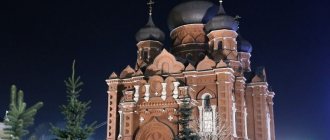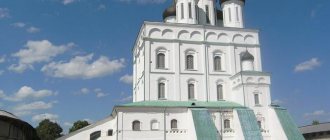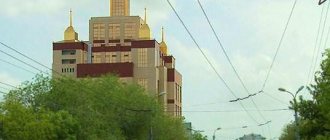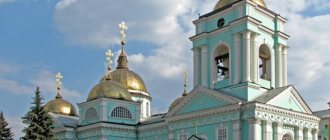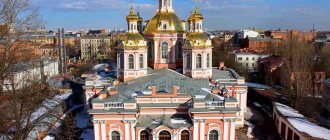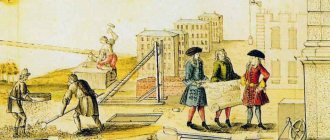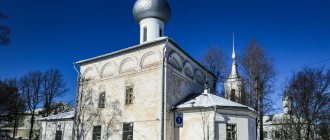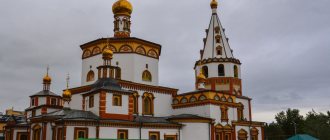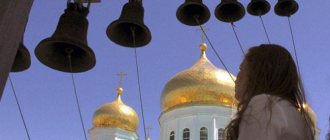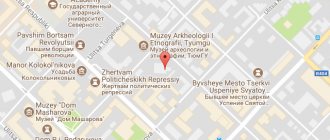| Omsk St. Nicholas Military Cossack Cathedral, July 14, 2009. Photo from the site sobory.ru |
Omsk Military Cossack Cathedral in the name of St. Nicholas the Wonderworker
of the Omsk diocese
- See: St. Nicholas the Wonderworker (chief); St. Simeon the God-Receiver and Anna the Prophetess (right) [1]; Vmch. St. George the Victorious (left) [1]
- Address: Russia, Omsk, st. Lenina, 27
- Tel.
- Official site:
- On the map: Yandex.Map, Google map
The oldest temple in Omsk, the only military temple of the city that survived during the years of Soviet power.
The church was founded on May 15, 1833 on the square of the Cossack Forstadt, opposite the Cossack military school. It was built with donations from the Cossacks of the Siberian Cossack Army and the efforts of various military commanders.
On May 26-27, 1840, Archpriest Dimitry Ponomarev consecrated the chapels of the warm church - Georgievsky and Simeon-Anninsky.
On September 16, 1843, the main altar was consecrated in the name of St. Nicholas the Wonderworker.
In 1840, the clergy was appointed consisting of a priest, a deacon and a cleric. From March 13, 1861, the clergy was to consist of two priests, a deacon, a sexton and a sexton. At the request of the diocesan authorities, in 1900 the Holy Synod opened a third staff of one priest and psalm-reader.
In September 1897, a four-year school for girls was opened at the temple. According to information from 1900, the school was located, for lack of its own building, in the house of the Cossack Konstantin Fedorov. The building for the school was built in 1903 from wood provided free of charge by the Military Economic Administration of the Siberian Cossack Army. In the early 1910s, there were two teachers at the school, and singing was taught free of charge by a psalm-reader.
| Omsk St. Nicholas Military Cossack Cathedral, photo of the beginning. XX century |
In the parish of the church there was also a military preparatory Cossack boarding school, two parish St. Nicholas schools (male and female), St. Nicholas men's school and two Cossack schools in the villages of Cheremukhovsky and Novy.
On December 11, 1903, parish guardianship was opened.
The parishioners of the temple were Cossacks from Omsk and surrounding villages. In the cathedral they blessed soldiers going to the front and served a memorial service for the dead. At different times, Tsarevich Nikolai Alexandrovich, P.A. prayed in the temple. Stolypin, L.G. Kornilov, A.V. Kolchak. The famous poet L.N. was baptized here. Martynov and the future Lieutenant General D.M. Karbysheva.
Archpriest Pavel Podbelsky and priest Leonid Pokrovsky in 1907 applied to raise the church to the status of a cathedral, but were refused.
In 1914, the Nikolsky orphanage for townspeople and Cossacks was opened at the temple. It also provided assistance to visiting children.
On October 24, 1915, under Bishop Sylvester (Olshevsky), the Parish Brotherhood in the name of St. Nicholas the Wonderworker of Myra was established.
In 1916, the temple was given the status of a cathedral.
During Soviet times
| Removal of the bells of the Omsk St. Nicholas Military Cossack Cathedral, January 1930. “Working Way” newspaper, photo. Gorokhov |
In 1920, the property of the cathedral was nationalized.
The priest of the cathedral, Fr. Sergiy Dmitrevsky. On November 3, 1921, an agreement was concluded with the “Community of Christians of the Orthodox Confession at the Omsk St. Nicholas Cathedral” for the use of the church building. In the same year, the state confiscated temple valuables.
The very next year, problems arose with registering the community and providing it with premises, since the Living Church group tried to rent all the churches in the city and the local political leadership supported the Living Church members.
In 1923, another “confiscation of valuables for the benefit of the starving” was carried out - silver vestments and other items. A church library of 500 books is mentioned. The banners of the military units located in the temple were transferred to the museum. In October of the same year, two nuns were killed.
On March 28, 1924, the “surplus” was confiscated by the policeman of the 1st department, Grabezhov.
On April 18 of the same year, the contract with the community was terminated, and church vestments and other items were transferred for temporary use to the Elias Church.
In May the cathedral was handed over to the Living Church members.
Archbishop of Omsk Victor (Epiphany) repeatedly made attempts to get the authorities to return the church, which he wanted to make a cathedral, but to no avail.
The archive of St. Nicholas Cathedral in 150 volumes and the library were located in the basement of the church; they are almost completely lost. The silver was handed over to the Omgubfinotdel. The plundered temple was empty, and the community, consisting of 31 people in 1927, had no premises.
In September 1928, it turned out that a brothel had been set up in the church: everything was torn, broken, scattered, looted.
In November of the same year, the city council decided to transfer the building for “cultural needs.”
On January 16, 1929, this decision was confirmed by the Regional Executive Committee.
On January 10, 1930, the Omsk District Administrative Department received a message that the All-Russian Central Executive Committee had approved the closure of St. Nicholas Cossack Cathedral. In mid-January of that year, the church bells were removed. The property, primarily the icons, disappeared without a trace. The roof of the dome and the bell tower were dismantled, and a third floor was built over the refectory and vestibule.
| The building of the Omsk St. Nicholas Military Cossack Cathedral, occupied by the Pobeda cinema. Photogr. 1940s |
Over the years, the “Builder” club, the cultural department, the music school, the cinema department, and the Pobeda cinema were located here.
In 1960, they wanted to demolish the cathedral, but it was saved by the protests of the intelligentsia.
Since 1966, the building has been abandoned.
In 1970, a decision was made by the city executive committee to demolish the building of St. Nicholas Church. The chairman of the city executive committee was then V.I. Bukhtiyarov, and his deputy N.G. Gritsevich. They relied on the conclusion of SibADI scientists, who argued that the building was in disrepair and impossible to operate. The artist K. Shchekotov, the head of the culture department of the city executive committee V. Chernyshev, the trust manager B. Karasikov and the architect M.M. spoke out against the destruction of the temple. Khakhaev.
In the late 1970s and early 1980s, restoration work was carried out.
Since 1983, there has been an organ in the temple.
Recent history
Since 1991, the temple building began to be used jointly by the department of culture and the Omsk diocese. It hosted peacekeeping, interfaith and other conferences, charity concerts, a circle of the Siberian Cossack Army, and a Sunday religious and moral school. On March 28, 1992, the founding meeting of the Omsk branch of the International Foundation of Slavic Literature and Culture took place in the cathedral.
In 1998, at the urgent requests of the believers of our city and the active support of the Siberian Cossacks, the organ was moved to the building of a former cinema.
In June of the same year, the cathedral was transferred to the Omsk diocesan administration.
Architecture and interior decoration
The design of the cathedral was based on the drawings of the architect V.P. Stasov, the author of numerous buildings in St. Petersburg and Moscow. A number of significant additions and changes were made to the project (3 thrones instead of the expected two, a vestibule with a bell tower was added, the height of the dome was increased, etc.). The icons for the church were painted by academician of painting M.I. Myagkov and artist P.M. Skorospelov. The iconostasis was made by Ekaterinburg masters P. Batov and I.A. Dulin. The bells were cast at the Loktevsky Mining Plant. The copper crosses were donated by the owner of the Verkhne-Isetsky plant, Yakovlev.
The temple is brick, one-story, in the shape of a “ship”. The height to the base of the bell tower spire is 24 m, to the cross - 33.5 m. The three entrances of the cathedral were decorated with Doric porticos. The main facade is accented by a Doric portico, decorated with decorative details and finished with a massive dandy. The bell tower is two-tiered, the lower tier is square in plan with arched openings, the upper tier of the bell is octagonal with arched openings. The bell tower is crowned with a tall spire with a cross.
The new iconostasis of the cathedral was made according to the design of V.N. Gulchenko by a team of carvers led by V.L. Malykh. The gilding of the iconostasis was carried out by Oleg Zotin. Temple icons were painted in the diocesan workshop headed by Gennady Adaev, icon painters D.N. Fofinykh, T. Golubeva, A. Kostylev, V. Khodykin, D. and N. Invincible.
Statistics
- 1840 – 2184 people
- 1895 - 4 villages, 4200 people in the parish (1975 municipal population, 2225 residential population)
- 1900 - 3 villages (Zakhlaminsky, Novy and Cheremukhovsky), 1,786 parishioners (868 m.p., 918 zh.p.), Old Believers of the non-priest persuasion - 9 people, “the population treats them indifferently, and on the part of the schismatics themselves there are no attempts to propaganda is not noticed" [2]
- 1914 - 3538 people in the parish (1637 municipal settlement, 1901 residential settlement), of which 2594 people were in the city, in the village. Novy - 613 people, in the village. Cheremukhovsky - 349 people; Old Believers of the non-priest persuasion - 3 people.
- 1922 - 119 people
- 1927 - 31 people
- 1928 - 50 people
Story
The roots of the cathedral's history date back to mid-May 1833. Then, on the 15th, its first stone was laid. The city authorities entrusted the construction of this building to the famous architect V.P. Stasov. At that time, he worked on the construction of elite premises in Moscow and St. Petersburg.
Funds for the construction of the cathedral were collected by the entire parish. The main amount was invested by the Siberian Cossacks, but there were many other philanthropists.
Construction actually lasted for seven years. On the hot days of June 1840, the church was consecrated. Archpriest Dmitry Ponomarev took upon himself this concern. He had to work carefully, since the temple still required a lot of improvements.
The Cossack St. Nicholas Cathedral took on part of the responsibilities for improving the education of the population, so in 1897 a special school for girls was formed on its territory. The training took place there for four years.
The Cossacks would not be themselves if the relics brought to the temple did not correspond to their essence. So, in 1883, the main relic was the banner of Ermak, on the canvas of which the image of St. Demetrius of Thessaloniki stood out clearly. The temple guarded its relic zealously, but the advent of Soviet power and the civil war changed the course of history, leading to many losses, including the main relic, the flag. Now a copy of it is kept in the cathedral.
At one time, the temple was visited by the following high-ranking guests:
- Nikolai Alexandrovich, Tsarevich (Nicholas II);
- Kolchak A.V.
- Kornilov L. G.
- Martynov L.N. (poet, baptized in church);
- Karbyshev D.M. (Lieutenant General, was baptized under the arches of the cathedral).
During the years of Soviet rule, the temple suffered the following changes and deprivations:
- the temple bell tower building was completely dismantled;
- all bells were melted down;
- The “Builder” club was first made from the temple complex, then the cultural department was settled here, then a music school was located within these walls, and then there was a confiscation department, and later a cinema called “Victory”.
With the advent of 1960, the authorities in Omsk wanted to completely dismantle the building. He was saved by intellectuals protesting against barbarism. The closed temple has remained empty and crumbling since 1966. This situation lasted until the early 80s of the 20th century. Then they decided to restore the Cossack Temple and carried out a series of restoration work. In 1893, to ensure that the restored premises did not become empty, an organ and chamber music hall was placed here, since this was facilitated by the acoustics of the building.
His Eminence Vladyka Theodosius (in 1991) partially returned the temple building to the Church. Now it was used by priests on equal terms with cultural and artistic workers. Only in 1998 were active believers able to achieve the eviction of the organ from the church to a former cinema and the transfer of the temple under the care of the Omsk-Tara diocesan administration.
Soviet time
With the coming to power of the Bolsheviks, difficult times came in the life of St. Nicholas Cathedral. After the defeat of the white movement, the Bolshevik government nationalized its property and shot one of its servants, Sergei Dmitrievsky. In November 1921, an agreement was concluded between the parish community and the city council of deputies for the lease of the building of St. Nicholas Cathedral, which was to be renewed every year.
Since the twenty-first year, church valuables have been confiscated annually under the pretext of helping residents of starving areas of the country. In 1924, the cathedral was handed over to the renovationists, with whose connivance its interior was completely plundered, icons were cut up, and some relics were destroyed.
Historical photo of the cathedral at the beginning of the twentieth century
1930 Spiritual activity within the walls of the St. Nicholas Cathedral building officially ceased. The Bolsheviks partially destroyed the desecrated building and rebuilt it. The bell tower, dome and drum were demolished, and a two-story extension was installed above the middle part.
For forty years, the building was used to house the following institutions:
- city club "Builder";
- regional department of culture;
- music school;
- cinema "Pobeda".
In the 60-70s. The city authorities repeatedly made attempts to finally demolish the historical building, but representatives of the city intelligentsia actively resisted this decision. They drew attention to the fact that in the capital, buildings created according to Stasov’s design were protected as an object of cultural heritage. The authorities listened to the opinion of experts and preserved the dilapidated building.
Interesting! There is an opinion that they tried to blow up the St. Nicholas Cathedral, but the walls stood, and the idea of demolition had to be forgotten.
Cathedral architecture
The initial architecture of the temple was changed during restoration work. They added another throne (now there are 3 of them), expanded the building with a new vestibule with a bell tower, and raised the dome higher. Besides all this, the temple has changed in various small ways. The general decorative style became more similar to architectural solutions in the construction of cultural buildings (including rural clubs).
An elongated rectangle, the height to the base of the spire is 24 m, to the base of the cross it is 33.5 m. All entrances, including the facade, are decorated with Doric porticoes; elements of stucco decoration and a massive dandy are visible on the front wall.
Literature
- Zimmerman E. Along the Great Siberian Railway // Bulletin of Europe. – 1903. – No. 1. – P. 126.
- Government Gazette. - 1918. - July; 1919. – July.
- Dawn. – 1918. – October 26.
- Dawn. – 1919. – May 13.
- Working path. – 1930. – January 11, March 2.
- New way. – 1934. – September 8.
- Shukhov I. Pictures of old Omsk // Omsk almanac. Book 5. - Omsk, 1945. - P. 82-87.
- Lebedeva N.I. St. Nicholas Military Cossack Church // Bulletin of Culture: Press Bulletin. – 1991. – No. 1. – P. 1, 7.
- Lebedeva N.I. Omsk churches // News of the Omsk State History and Local Lore Museum. - 1993 - No. 2. - P. 99-102.
- Lebedeva N.I. Architecture of churches in Omsk in the 18th - early 20th centuries. // Monuments of history and culture of the Omsk region. - Omsk, 1995. - P. 99-100.
- Lebedeva N.I. Monuments of religious architecture in the dynamics of cultural and historical realities of the 20th century (Based on materials from the Omsk Irtysh region). diss. for the job application scientific degree of candidate of historical sciences. – Omsk, 2000.
Holy relics
The following relics are preserved in the temple:
- ark with particles of the relics of 13 saints
- On the sides of the main iconostasis there are niches in which the relics of Saints Seraphim of Sarov and Theodosius of Chernigov are placed.
- Icons of locally revered saints
Used materials
- Pages of the official website of the cathedral
- Lebedeva N.I. St. Nicholas Cossack Church (cathedral since 1916) in Omsk.
- Losunov A. St. Nicholas Cossack Cathedral. Pages of history.
- Tobolsk diocesan address-calendar for 1895, p. 118.
- Skalsky K.F. Omsk diocese. Experience in geographical and historical-statistical description of cities, villages, villages and settlements that are part of the Omsk diocese. - Omsk, 1900, p. 44-46.
- Reference book of the Omsk diocese / Comp. priest John Goloshubin. - Omsk: Printing house “Irtysh”, 1914, p. 19-21.
[1] According to pre-revolutionary sources
[2] Skalsky, p. 46.
Photos
The square is always cozy and green, the air near the temple is fresh:
The entrance from the bell tower is decorated with decorative columns:
And this is what the old temple looked like:
The interior of the temple is very bright:
This cathedral is as strong, long-suffering and reliable as the Cossacks themselves. He depends on the believers, but he also helps them a lot. In joy and in days of sadness, everyone will find consolation here.
Renaissance
The first step towards the revival of the historical building as a place of worship was its partial restoration, carried out at the turn of the 70-80s of the last century. Since 1983, the organ music hall has been located here.
In the 90s The building was jointly used by the Omsk diocese and the department of culture. Various social and cultural events were held here, a meeting of the Siberian Cossack Army, and Sunday School classes were also held. But staying within the walls of the former organ temple was reflected in the condition of its walls. Through the efforts of believing townspeople and representatives of the Siberian Cossacks, the instrument was moved to the cinema building. Since June 1998, the building came under the control of the Omsk diocese.
On a note! To date, the cathedral has been restored to its original form, but restoration work is still ongoing. At the same time, divine services are held in the temple and all church sacraments are performed.
History[edit]
On October 28, 1907, the Cossacks of the Omsk village made a decision to allocate money for the construction of the temple from the income for 10 rental places. From the certificate of the Spiritual Consistory we learn that in the Ataman village there were then 9808 inhabitants, in the Black Town - 4924, on the left bank of the Irtysh - 369, in the village along the Semipalatinsk tract - 3500. In total - 18601 people. The suburbs of Omsk were the most multi-confessional: 13,504 Orthodox, as well as Catholics, Protestants, “sectarians” and representatives of other confessions. The need to build a temple was obvious, since the Trinity Church near the station could accommodate only 1000 people.
The stone three-altar church not far from the Omsk station was founded on May 9, 1911 by the Omsk Eminence Vladimir, in the presence of the Military Ataman of the Siberian Cossack Army, cavalry general Evgeniy Ottovich Schmidt.
The consecration of the temple was performed by Bishop Andronik of Omsk and Pavlodar on August 29, 1913. The main altar is in the name of the saint and wonderworker Nicholas of Myra, the second in the name of the holy Queen Alexandra, the third in the name of St. Alexy, Metropolitan of Moscow. Funds for the construction of the temple - 85,000 rubles - were collected by the Cossacks of the Ataman village with small outside donations. The celebration began on August 28 with an all-night vigil, attended by a host of clergy led by His Grace Andronik, who was greeted by the Cossacks with bread and salt before entering the temple, and with a cross upon entering the temple by the rector, Father John Popov. The next morning, with the solemn ringing of bells, a religious procession with holy relics arrived from the neighboring Trinity Church, accompanied by many people, and after it the Bishop came. After the consecration of the Throne, the first liturgy was served. Eyewitnesses noted the splendor of the temple and the solemnity of the service. “...The mighty singing of “I Believe” and “Our Father” by a nationwide choir of thousands carried away thoughts and hearts to the One Whom Orthodox Christians sang “with one mouth and one heart.” It was some kind of special, indescribable, powerful singing that carried all a person’s thoughts upward,” wrote church elder V. Nikitin. The consecration of the temple in the name of the namesake saints of the royal family: Queen Alexandra and St. Alexis took place on the day of the beheading of the head of St. John the Baptist, which coincided with the day of the All-Russian holiday of sobriety. The Bishop in his speech pointed out “the power of faith”, which in two years “erected this heavenly temple” and invited parishioners to lead a sober life.
In 1913, the Orthodox population in the parish was 5,600 people; 40 non-Orthodox, 385 non-Orthodox, 5 schismatics and 190 Baptists lived on the territory of the parish. The temple staff included 2 priests, a deacon and a psalm-reader. All of them were teachers of the Law of God in educational institutions: the 1st Ataman one-class Cossack mixed school, the 2nd Ataman mixed one-class school for commoners, the Shcheglova primary mixed school, administered by the Ministry of Public Education, the two-class mixed railway school of the MNP in “Port- Arthur" and at the Omsk station. For the clergy and the church, the Military Administration of the Siberian Cossack Army allocated 300 acres of land at the disposal of the Cossack society of the Ataman village. One of the priests of the temple served as a district missionary for the Omsk district.
